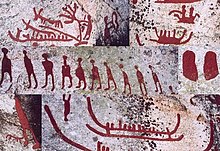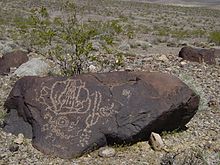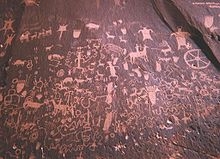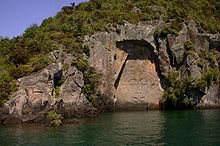Petroglyph

A petroglyph (from the Greek πέτρος petros “stone” and γλύφειν glýphein “carve”) is a rock carved in stone ( English rock art ) from prehistoric times. In contrast to rock painting , a petroglyph is engraved, scraped or picked and thus sunk into the ground.
Distribution and importance
Petroglyphs are common all over the world except in Antarctica . They have existed in Europe since the Aurignacia . This makes them one of the earliest artistic expressions of anatomically modern humans ( Homo sapiens ).
Often the representations have a high cultural and religious significance for the communities from which they originate . Recognizing the meaning of petroglyphs is only possible, if at all, with a very good knowledge of the respective culture. Research into the meaning of petroglyphs is the subject of archeology and ethnology .
techniques
There are three basic techniques for making petroglyphs, which can often be applied to the same motif:
- Engraving (or scoring ) identifies the recessing of thin lines in the rock using a hard object;
- Cockroaches (or loops ) denotes the recessing of surfaces by rubbing movements;
- Picken (or punches ) denotes the recessing of surfaces by striking or knocking movements, with a very uneven relief is formed.
Beginnings
Paleolithic carvings
The oldest scratches recognized as a cultural manifestation are on two hematite pieces that were found in the Blombos Cave (South Africa) and are dated to 77,000 years due to their layering. However, these are not petroglyphs, as the hematite pieces were not part of the cave wall, but objects of mobile Upper Paleolithic small art .
As the oldest known petroglyphs in the surrounding rock, scratches in a cave in Gibraltar can be seen since 2014 . The simple forms of intersecting lines are assigned to the Moustérien and thus to the Neanderthals . Deposits above the lines could be dated to an age of at least 39,000 years, so the incisions must be older. Much more complex carvings by modern man have been known since the Aurignacia . In caves in the Dordogne and Charente departments , including La Ferrassie and the Pair-non-Pair cave , wall reliefs were found that incorporate the natural shapes of the cave walls ("cave topography") into the picture.
The most extensive site landscape with petroglyphs in Europe is in the northern Portuguese Côa Valley , which was developed as an archaeological park ( Parque Arqueológico do Vale do Côa ). The illustrations in the Côa Valley are mostly dated to the Solutréen for stylistic reasons .
The only paleolithic petroglyphs in Germany so far are located near Gondershausen in the Hunsrück. They are 20,000 to 25,000 years old. In the 1930s, the Kelheim taxidermist Oskar Rieger discovered lines in the rock face in the Kastlhang cave near Pillhausen (Lower Altmühltal ), which he believed to be the engraving of an ibex. As the paleontologist Karl Dietrich Adam explains, these are instead natural fissures in the rock that simulate what appears to be an engraving. In contrast, the figure of a cervid (red deer) on the wall of the Kleiner Schulerloch ( abri below the Großer Schulerloch ), also discovered by Oskar Rieger in 1937, is to be regarded as authentic. The adjacent runes of the older Futhark are evidently related to this and suggest that the entire engraving dates back to the early Middle Ages (6th to 7th centuries).
From Gönnersdorf (Neuwied) , slate carvings made about 15,000 years ago from the Magdalenian period are known. The representations have the following contents: animals, dancers as well as symbolic incisions that defy interpretation.
Neolithic carvings on megaliths and cave walls
Very old engravings on worked monoliths are known from Göbekli Tepe in Turkey. Many rock carvings in Europe have been handed down on megaliths (burial chambers, steles, menhirs ). Petroglyphs in Breton (e.g. Gavrinis , Les Pierres-Plates ), Irish ( Dowth , Knowth , Fourknocks , Newgrange ) and Welsh ( Barclodiad y Gawres ) are known as abstract characters . Concentric circles and spirals are very common along with zigzag patterns (waves). The Maltese altar carvings from the Tarxian phase represent a particularly fine form of carving . In the younger rock chambers of the Domus de Janas of Sardinia, they are anthropomorphic, but mostly designed as bull horns.
Scoring on rock outcrops and stones
In Scotland (e.g. in Kilmartin Valley) there is a Neolithic or Bronze Age form of rock carving known as cup-and-ring marking . Cup-shaped depressions as bowls or bowls can be found on so-called bowl stones and on megalithic systems ( large stone grave from Bunsoh , stone box from Horne ). The Bronze Age rock carvings were mostly made on rocks that had been smoothed by glacial polishing. You can find carvings in Sweden ( Tanum , Brandskog, Kivik , Litsleby, Nämforsen and Sagaholm ), in Norway (called helleristninger, e.g. in Alta , Hornesfeltet and Solbergfeltet ), in Denmark (e.g. Madsebakke (Allinge-Sandvig) on Bornholm ), in Spain (Andalusia, Extremadura, Galicia), in Portugal ( Parque Arqueológico do Vale do Côa ), in Italy (in Val Camonica ), in France (on Mont Bégo ) and in Switzerland ( Carschenna ).
The themes of the representations correspond to the social practice of their creators. So are z. B. in Norway (Trøndelag, Tykamvatn) and northern Sweden to find hunting representations (animal style). During the Late Bronze Age and the earlier Iron Age , depictions of ships were common in Scandinavia. But there are also cult cars . Because of the great similarity with images on razors, these petroglyphs were already viewed by JJA Worsaae as being at the same time and correctly assigned to the younger Bronze Age.
Superimposition
The overpainting or overdrawing of existing pictures, the superimposition (also called superposition) also occurs in rock art, whereby the term superimposition is mainly used when it is clear which elements are older and which are younger. A lack of space cannot have been the decisive factor for the existence of superimposition, as there was often enough free space in the immediate vicinity of overdrawings.
Sources (selection)
Europe
Germany
- Lower Saxony: Stone box from Anderlingen
- Saxony-Anhalt: stone chamber from Göhlitzsch and other stone chamber graves with interior decoration; ornate flagstones and statue menhirs ; Langer Stein near Eilsleben (Börde district) with pickings
- Hessen: stone chamber grave of Züschen
- North Rhine-Westphalia: Warburg stone chamber
- Bavaria: Bamberg idols (decorated statue menhirs); in the Alpine region: Jachenau , upper valley of the Ammer near the Pürschling
- Rhineland-Palatinate: Petroglyphs from the Paleolithic near Gondershausen in the Hunsrück .
Austria
- Wurzeralm , Upper Austria
- Kienbachklamm , Upper Austria
- Notgasse, Styria
- Steinberg, Tyrol

- England
France
- Mont Bégo
- Vallée des Merveilles in the French Mercantour National Park
- Pair-non-Pair cave ( Gironde department )
- Les Combarelles
- La Ferrassie
- Rouffignac
Ireland
Spain
- Monte Tetón Archaeological Park , Galicia
- Laxe das Rodas , Galicia
- in the Canary Islands , e.g. B. the rock engravings by El Cementerio , the rock carvings on El Hierro or the rock engravings by La Fajana
- In Asturias in the Tito Bustillo cave

Portugal
Italy
- Tschötscher Heide, South Tyrol
Greece

Scandinavia
- Alta Museum , open-air museum in Norway
- Bjørnstad ship
- Rock carvings by Boglösa
- Rock carvings near Bøla Norway
- Rock carvings from Tanum , UNESCO World Heritage Site
- Rock carvings near Allinge-Sandvig
- Slagsta rock carving
Russia
- Belomorsk petroglyphs in the Republic of Karelia
- Onega petroglyphs at the mouth of the Wodla in Lake Onega near Pudosch , Republic of Karelia
Rock engravings in the
Vallée des Merveilles , Maritime Alps , FrancePetroglyph in Roque Bentayga, Gran Canaria , Canary Islands
Rock carving in Tanum , Sweden

North America
- Petroglyph Provincial Park , Nanaimo , British Columbia , Canada
- Kejimkujik National Park
- Dinosaur National Monument
- Petrified Forest National Park
- Petroglyph National Monument
- Winnemucca Lake , Nevada. The oldest petroglyphs on the American continent
- Horsethief Lake State Park
- West Virginia
- Valley of Fire State Park
- Newspaper Rock State Historic Monument in Canyonlands National Park
- Map Rock, Idaho , north of the Snake River
- Three Rivers Petroglyph Site in New Mexico
Latin America
- Isla de Ometepe in Lake Nicaragua , Nicaragua
- Los Haitises National Park caves , Dominican Republic
- Trois-Rivières in Guadeloupe
- Talampaya National Park in La Rioja Province, Argentina
- Serra da Capivara in the state of Piauí , Brazil
- Valle de Tarapaca near Arica , Chile
- La Abra, Cundinamarca , Colombia
- Parque Nacional Natural Chiribiquete , Colombia
- Chiquihuitillos, in the state of Nuevo León , Mexico
- La Proveedora Cave, in Sonora , Mexico
- Bum Bum in the state of Barinas , Venezuela
Africa
- Sahara rock art
- Rock carvings in Morocco
- Dabous giraffes in Niger
- Twyfelfontein in Namibia (UNESCO World Heritage Site since 2007)
Asia
- Qobustan National Park in Azerbaijan , UNESCO World Heritage Site, National Historic-Artistic Reserve
- Mt.Sulaiman and Cholpon-Ata in Kyrgyzstan
- Rock art on the Karakoram Highway
- Tamgaly , Eastern Kazakhstan , since 2004 UNESCO - World Heritage Site
- Teymareh and other sites in Iran
- Edakkal Caves , Kerala , India
- Petroglyphs in the Philippines
- Surroundings of Aqaba
- Rock carvings at Big Wave Bay (Hong Kong)
- Lene Hara , East Timor
Australia and New Zealand
- Murujuga Peninsula (Burrup Peninsula) in front of the Dampier Archipelago , hundreds of thousands of images, the " Aboriginal Bible ", are threatened by large-scale industrial development
- In Kakadu National Park , Northern Territory , especially at Ubirr and Nourlangie Rock, you can see many rock carvings up to 20,000 years old.
- There are also many rock carvings at Uluru (Ayers Rock).
- on Lake Taupo on the North Island of New Zealand . The Māori rock carvings are only accessible by boat. They serve here only as an example of traditional Māori art, because they were not made from a prehistoric past, but rather over the last 50 years.
See also
literature
- Karl Dietrich Adam , Renate Kurz: Ice Age Art in Southern Germany. Theiss, Stuttgart 1980, ISBN 3-8062-0241-9 .
- Herbert Kühn : The rock art of Europe. Kohlhammer, Stuttgart 1952.
- Detlef W. Müller: Petroglyphs from Middle Neolithic graves of Saxony-Anhalt. In: Karl W. Beinhauer et al. (Hrsg.): Studies on megalithics. State of research and ethnoarchaeological perspectives. = The megalithic phenomenon. Recent research and ethnoarchaeological approaches (= contributions to the prehistory and early history of Central Europe. Vol. 21). Beier & Beran, Mannheim et al. 1999, ISBN 3-930036-36-3 , pp. 199-214.
media
- Treasures of the world - legacies of humanity. The rock engravings from Twyfelfontein , Namibia - Encrypted stone message. TV report, Germany, 2008, 14:31 min., Script and direction: Christian Romanowski, production: SWR , first broadcast: December 23, 2008, online with online video
Individual evidence
- ↑ Christopher S. Henshilwood et al: Emergence of Modern Human Behavior: Middle Stone Age Engravings from South Africa. In: Science . Vol. 295, 2002, pp. 1278-1280, doi : 10.1126 / science.1067575 . See also the illustration at spiegel.de from January 11, 2002: Stone Age artist carved enigmatic signs. or in The Japan Times , January 13, 2002
- ↑ Joaquín Rodríguez-Vidal, Francesco d'Errico, et al .: A rock engraving made by Neanderthals in Gibraltar . In: PNAS, approved on August 12, 2014, doi: 10.1073 / pnas.1411529111
- ↑ a b Adam, Kurz: Eiszeitkunst in southern Germany. 1980, pp. 71-72, 107-108.
- ↑ Adam, Kurz: Eiszeitkunst in southern Germany. 1980, p. 57.
- ↑ Adam, Kurz: Eiszeitkunst in southern Germany. 1980, pp. 71-72.
- ^ Jost Gudelius: The Jachenau. Including the chronicle of Johannes Nar from 1933 including the family history contribution by Josef Demleitner from 1933 and the geological contribution by Kurt Kment from 2004. Jachenau community, Jachenau 2008, ISBN 978-3-939751-97-7 , p. 20.
- ↑ Garmischer Tagblatt: Origin before the birth of Christ? , June 24, 2009, p. 10.
- ↑ Spiegel online: Hunsrück: Rock engravings from the Paleolithic in Germany discovered for the first time , July 3, 2014
- ↑ Tito Bustillo Cave Art. Sociedad pública de gestión y promoción turística y cultural del Principado de Asturias, Centro de Arte Rupestre Tito Bustillo, accessed on February 14, 2020 (English).
- ↑ Three Rivers Petroglyphs (English)
- ^ "Gobustan Rock Art Cultural Landscape" , UNESCO World Heritage Center
- ^ "Gobustan National Historical-Artistic Preserve"
- ^ "Petroglyphs within the Archaeological Landscape of Tamgaly" , UNESCO World Heritage Center
- ↑ Iranrockart, page by researcher M Naserifard ( Memento of the original from July 19, 2014 in the Internet Archive ) Info: The archive link was inserted automatically and has not yet been checked. Please check the original and archive link according to the instructions and then remove this notice.
- ↑ Middle East rock art archive- Iran Rock Art
- ↑ Dirk Hecht, Rock Art in the Aqaba Area. In: Orient-Archäologie Volume 23 (2009), 113–126
- ↑ WDR : “The treasure of Murujuga. Natural gas giant threatens oldest Aboriginal cultural heritage ” (PDF; 86 kB), WDR , May 4, 2008
- ^ Archeology and rock art in the Dampier Archipelago









